|
|
|
Sort Order |
|
|
|
Items / Page
|
|
|
|
|
|
|
| Srl | Item |
| 1 |
ID:
112436


|
|
|
|
|
| Publication |
2012.
|
| Summary/Abstract |
This paper identifies imaginings since the early 1990s to reposition Yunnan from a peripheral province in the PRC to the centre of various regional constructs which involve territories across the PRC's borders, primarily in what are now known as southeast and south Asia. These narratives, which change over time and between actors, are justified using Yunnan's past linkages with territories along the 'southern silk road' and through a naturalized presentation of its geographical location and characteristics, are based on the premise of good neighbourly relations, and are driven by imperatives of development. They find practical expression in provincial engagement with regional institutions, and in infrastructure and other programmes. However, the imaginings to reposition the province which these narratives spell out are at the same time constrained by the demands of territorial integrity and national security: a desire not to compromise Yunnan's national belonging. The paper concludes by commenting on implications for understanding 'China's borderlands' and their global interactions.
|
|
|
|
|
|
|
|
|
|
|
|
|
|
|
|
| 2 |
ID:
146951
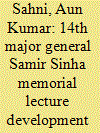

|
|
|
| 3 |
ID:
117740
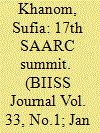

|
|
|
|
|
| Publication |
2012.
|
| Summary/Abstract |
This paper attempts to analyse the discussed issues and outcomes of the seventeenth SAARC Summit which took place in the Maldives from 10-11 November 2011 with a special reference to Bangladesh in the context of regional cooperation. Several significant and strategically important agreements were signed during this Summit with the intention to begin a new era of cooperation among the member countries. Therefore, the Summit declaration adopted several treaties like SAARC Agreement on Rapid Response to Natural Disasters, SAARC Seed Bank, SAARC Agreement on Multilateral Arrangement on Recognition of Conformity Assessment, and the SAARC Agreement on Implementation of Regional Standards. The agreements focused on enhancing and facilitating regional transit and connectivity, economic growth, ensuring energy security, combating terrorism and human trafficking and fight climate change. Though the Summit has come up with some promising mutual agreements, its success will depend on their proper and timely implementation. The lack of political will, problem of poor governance, weak economy and disparity, crisis of political leadership, ethnic, socio-cultural and religious divisions, challenges of non-state actors, transnational security challenges are considered to be the major hindrances to the success of regional integration. The South Asian region should develop its own short, medium, and long-term strategies for economic integration where each stage should be implemented effectively before moving on to the next in order to build a sound foundation for progress. The inclusion of China as 'dialogue partner' would help SAARC to make the tangible progress for regional cooperation in South Asia. The new focus on regional integrations is likely to create exciting opportunities for Bangladesh if it can exploit the synergies based on comparative advantages, investment in cross-border infrastructure projects, address challenges in governance, environmental and social developments.
|
|
|
|
|
|
|
|
|
|
|
|
|
|
|
|
| 4 |
ID:
185538
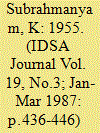

|
|
|
| 5 |
ID:
019904
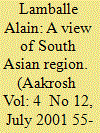

|
|
|
|
|
| Publication |
July 2001.
|
| Description |
55-72
|
|
|
|
|
|
|
|
|
|
|
|
|
|
|
|
| 6 |
ID:
059744
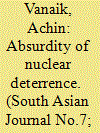

|
|
|
|
|
| Publication |
Jan-Mar 2005.
|
|
|
|
|
|
|
|
|
|
|
|
|
|
|
|
| 7 |
ID:
171172
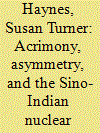

|
|
|
|
|
| Summary/Abstract |
While most contemporary analyses of South Asian nuclear dynamics acknowledge the presence of a strategic triangle between the region’s three nuclear players, the primary focus usually remains on the rivalry between India and Pakistan. Discussions of Sino-Indian relations remain limited. This is likely attributed to the stability in the two countries’ relations, yet it is worth asking why this stability exists and whether it is likely to continue in the future. Although China and India have an acrimonious relationship, their asymmetric nuclear capabilities and threat perceptions mitigate the danger of a traditional security dilemma. India may perceive China’s nuclear aggrandizement to be a security threat, but the same is not true of China, which has a vastly superior nuclear force and is largely shaping its nuclear-force structure in response to the threat it perceives from the United States. This dynamic makes a serious conventional or nuclear conflict highly unlikely.
|
|
|
|
|
|
|
|
|
|
|
|
|
|
|
|
| 8 |
ID:
155257
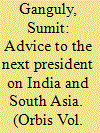

|
|
|
|
|
| Summary/Abstract |
A change in U.S. administrations can often result in significant policy shifts. However, in the case of South Asia, with marked exceptions, U.S. policy has been mostly consistent. That said, the new administration will confront important challenges at global, regional, and bilateral levels that involve South Asia. To that end, the administration will have to deal with questions of climate change, global trade, and transnational terror. It will also have to confront the nettlesome question of the future of Afghanistan as well as the growing religious intolerance and conflict in the overall region. Finally, given India’s significance to the region and beyond, it will need to devise policies designed to place the bilateral relationship on a more secure footing.
|
|
|
|
|
|
|
|
|
|
|
|
|
|
|
|
| 9 |
ID:
139357
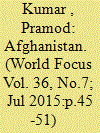

|
|
|
|
|
| Summary/Abstract |
There is hardly anything as dynamic as the world politics. This is very clear from the situation which prevails in Afghanistan. Great Surgeons come from different corners of the world, with latest surgical instruments and a long list of medicines, to do the surgery in Afghanistan and make it healthy and wealthy, fail, and return to their home land with a long face.
|
|
|
|
|
|
|
|
|
|
|
|
|
|
|
|
| 10 |
ID:
128388
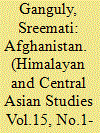

|
|
|
|
|
| Publication |
2011.
|
| Summary/Abstract |
In the context of conventional notion of Afghanistan's foreign policy strategy, two countries are accorded the most prominent status- the U.S. and Pakistan. Russia, on the other hand, shares a unique relationship with Afghanistan. The role of the buffer state, as played out by Afghanistan, during the 19"' century, halted Russian adventure towards ' South Asia, and Russian invasion of Afghanistan proved to be so much of a miscalculated affair as the misadventure led to the collapse of the Soviet Union itself. But even now, Russia has a great stake in Afghanistan's stability and is still considered to be a stabilizing factor in Afghanistan's security scenario. This paper analyzes the different phases of Russian involvement in Afghanistan in t international strategic environment.
|
|
|
|
|
|
|
|
|
|
|
|
|
|
|
|
| 11 |
ID:
127660
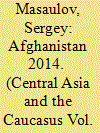

|
|
|
|
|
| Publication |
2013.
|
| Summary/Abstract |
The continuing destabilization of public life in Afghanistan and far from always successful attempts by the International Security Assistance Force (ISAF) to return it to normal are creating fundamental challenges and threats to regional and global security.
The following problems can be identified:
1. Higher drug production and circulation. This is causing a steady rise in both the number of people dependent on heroin and opiates coming from Afghanistan and the total number of drug addicts (according to experts, 36,000 young people die from drugs in Russia every year).
2. Stronger transnational crime groups in Central Asia (CA). Their activity is closely related to the drug business and movement of drugs from Afghanistan to Russia and Europe through the Central Asian countries.
3. Continued presence of armed U.S. and NATO forces in Afghanistan and its neighboring states in the form of their network of super bases is not helping to combat the threat of terrorism.
In recent years, it has become obvious that the CA states are facing a complex problem manifested in a dramatic deterioration of the internal situation in Afghanistan and Pakistan; an increase in the fragmentary Talibanization factor; similar situations in the border areas of Afghanistan and Pakistan; and an aggravation of the Pashtun issue.
The problem is that some of the former ideas about what is going on in Afghanistan do not correspond to current reality. It is incorrect to take the simplified approach and reduce the entire problem to the existence of the Taliban movement, under which all those drawn into the struggle against the ISAF in the wake of various ideas and slogans are lumped. Several Taliban centers function in Afghanistan and Pakistan (radical, extremist, and moderate).
The policy of the CA states should not be limited to endowing the large nations with the right to resolve the Afghan-Pakistani problems. States with interests in the country that are capable of having an impact on the development of the situation must also be engaged to untie the "Afghan knot"; the matter primarily concerns Russia, China, Iran, and the CA countries.
|
|
|
|
|
|
|
|
|
|
|
|
|
|
|
|
| 12 |
ID:
128387
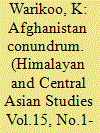

|
|
|
|
|
| Publication |
2011.
|
| Summary/Abstract |
Located at the crossroads of Central, South and West Asia and sharing. its borders with Central Asian Republics of Tajikistan, Uzbekistan and Turkmenistan on the north, Chinese province of Xinjiang in the east, [ran on the west and south west, and Pakistan and Pak-occu pied Kashmir on the south and south east, Afghanistan occupies a unique geo-strategic placement in the region. Distinct ethno-linguistic groups settled in different parts of .»'\fghanistan have diverse social moorings and political affiliations and aspirations. Th us the 'I'ajil
|
|
|
|
|
|
|
|
|
|
|
|
|
|
|
|
| 13 |
ID:
013199
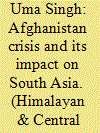

|
|
|
|
|
| Publication |
July-Sept 1997.
|
| Description |
63-78
|
|
|
|
|
|
|
|
|
|
|
|
|
|
|
|
| 14 |
ID:
130888
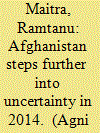

|
|
|
|
|
| Publication |
2014.
|
| Summary/Abstract |
2014 was long anticipated as the year of transition and ushering in of hope for Afghanistan. Three months of this important year are already behind us and, betraying earlier expectations, afghans continue to face stark uncertainties.
|
|
|
|
|
|
|
|
|
|
|
|
|
|
|
|
| 15 |
ID:
145934
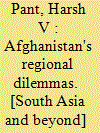

|
|
|
|
|
| Publication |
New Delhi, Orient BlackSwan Pvt. Ltd., 2016.
|
| Description |
xiv, 180p.hbk
|
| Series |
Strategic Studies
|
| Standard Number |
9788125063223
|
|
|
|
|
|
|
|
|
|
|
|
Copies: C:1/I:0,R:0,Q:0
Circulation
| Accession# | Call# | Current Location | Status | Policy | Location |
| 058719 | 327.10109581/PAN 058719 | Main | On Shelf | General | |
|
|
|
|
| 16 |
ID:
190941
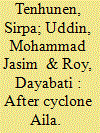

|
|
|
|
|
| Summary/Abstract |
This article compares the politics of climate change in the Sundarbans region in Bangladesh and India based on ethnographic fieldwork in four villages and among migrants from these villages in Kolkata and Khulna city by focusing on the long aftermath of cyclone Aila. The comparison highlights different policy options and framings of extreme weather events . Ten years after the cyclone, the aftermath of Aila continues in both regions we studied in Bangladesh and India, but partly for different reasons. In our study areas in Bangladesh, the aftermath of Aila reinforced the neglect of coastal livelihoods, whereas, in the communities we studied in India, Aila spurred new investments in the affected areas. By comparing how the political is interwoven with the natural, we demonstrate how Aila's lingering impacts have emerged as part of local power relationships and diverse forms of agency. We highlight the multiplicity of policy responses and people's practices not only between communities and countries facing a similar predicament but also within the communities themselves. We argue that the politics of climate change is not only about climate change policy to mitigate the impact of ecological disasters but also about the reconstruction of political agents and practices.
|
|
|
|
|
|
|
|
|
|
|
|
|
|
|
|
| 17 |
ID:
193294
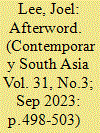

|
|
|
|
|
| Summary/Abstract |
This afterword critically engages with the introduction and five essays of this special section on Muslim caste associations, illuminating their distinctive contributions and posing questions toward the further development of a collective research agenda.
|
|
|
|
|
|
|
|
|
|
|
|
|
|
|
|
| 18 |
ID:
157408
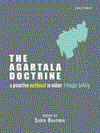

|
|
|
|
|
| Publication |
New Delhi, Oxford University Press, 2016.
|
| Description |
xvi, 344p.: tables, figureshbk
|
| Standard Number |
9780199463800
|
|
|
|
|
|
|
|
|
|
|
|
Copies: C:1/I:0,R:0,Q:0
Circulation
| Accession# | Call# | Current Location | Status | Policy | Location |
| 059303 | 327.54/BHA 059303 | Main | On Shelf | General | |
|
|
|
|
| 19 |
ID:
051385
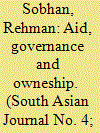

|
|
|
|
|
| Publication |
Apr-Jun 2004.
|
|
|
|
|
|
|
|
|
|
|
|
|
|
|
|
| 20 |
ID:
157616
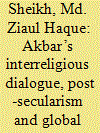

|
|
|
|
|
| Summary/Abstract |
Samuel Moyn and Andrew Sartori depict a conceptual map of a range of
possible approaches and ways in which Global Intellectual History (GIH) can
be formulated as an academic discipline. Various scholars from different fields
propose to widen its scope and boundaries - from trans-local and westerncentric
to intra-regional, trans-continental, trans-national and even beyond the
geographical designation. In this writing, an attempt has been made to bring the
idea of “Suhl-i-kul”, a state sponsored ‘interreligious-dialogue’ initiated by Akbar
(1556-1605), a mediaeval Mughal emperor of India, as a content of GIH. This
study assumes that the concept of “Suhl-i-kul” can be matched with the idea of
‘post-secularism’ which demands that such concept can create a trans-religious
global formation and contribute to establish a peaceful society in a religiously
pluralist world, especially from the perspective of multi-religious South Asia.
|
|
|
|
|
|
|
|
|
|
|
|
|
|
|
|
|
|
|
|
|